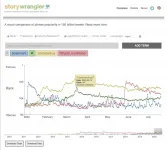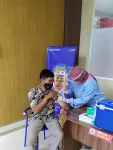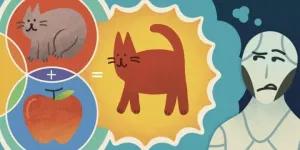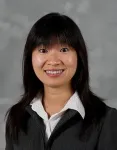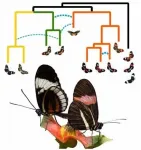(Press-News.org) For thousands of years, people looked into the night sky with their naked eyes -- and told stories about the few visible stars. Then we invented telescopes. In 1840, the philosopher Thomas Carlyle claimed that "the history of the world is but the biography of great men." Then we started posting on Twitter.
Now scientists have invented an instrument to peer deeply into the billions and billions of posts made on Twitter since 2008 -- and have begun to uncover the vast galaxy of stories that they contain.
"We call it the Storywrangler," says Thayer Alshaabi, a doctoral student at the University of Vermont who co-led the new research. "It's like a telescope to look -- in real time -- at all this data that people share on social media. We hope people will use it themselves, in the same way you might look up at the stars and ask your own questions."
The new tool can give an unprecedented, minute-by-minute view of popularity, from rising political movements to box office flops; from the staggering success of K-pop to signals of emerging new diseases.
The story of the Storywrangler -- a curation and analysis of over 150 billion tweets--and some of its key findings were published on July 16 in the journal Science Advances.
EXPRESSIONS OF THE MANY
The team of eight scientists who invented Storywrangler -- from the University of Vermont, Charles River Analytics, and MassMutual Data Science -- gather about ten percent of all the tweets made every day, around the globe. For each day, they break these tweets into single bits, as well as pairs and triplets, generating frequencies from more than a trillion words, hashtags, handles, symbols and emoji, like "Super Bowl," "Black Lives Matter," "gravitational waves," "#metoo," "coronavirus," and "keto diet."
"This is the first visualization tool that allows you to look at one-, two-, and three-word phrases, across 150 different languages, from the inception of Twitter to the present," says Jane Adams, a co-author on the new study who recently finished a three-year position as a data-visualization artist-in-residence at UVM's Complex Systems Center.
The online tool, powered by UVM's supercomputer at the Vermont Advanced Computing Core, provides a powerful lens for viewing and analyzing the rise and fall of words, ideas, and stories each day among people around the world. "It's important because it shows major discourses as they're happening," Adams says. "It's quantifying collective attention." Though Twitter does not represent the whole of humanity, it is used by a very large and diverse group of people, which means that it "encodes popularity and spreading," the scientists write, giving a novel view of discourse not just of famous people, like political figures and celebrities, but also the daily "expressions of the many," the team notes.
In one striking test of the vast dataset on the Storywrangler, the team showed that it could be used to potentially predict political and financial turmoil. They examined the percent change in the use of the words "rebellion" and "crackdown" in various regions of the world. They found that the rise and fall of these terms was significantly associated with change in a well-established index of geopolitical risk for those same places.
WHAT'S HAPPENING?
The global story now being written on social media brings billions of voices -- commenting and sharing, complaining and attacking -- and, in all cases, recording -- about world wars, weird cats, political movements, new music, what's for dinner, deadly diseases, favorite soccer stars, religious hopes and dirty jokes.
"The Storywrangler gives us a data-driven way to index what regular people are talking about in everyday conversations, not just what reporters or authors have chosen; it's not just the educated or the wealthy or cultural elites," says applied mathematician Chris Danforth, a professor at the University of Vermont who co-led the creation of the StoryWrangler with his colleague Peter Dodds. Together, they run UVM's Computational Story Lab.
"This is part of the evolution of science," says Dodds, an expert on complex systems and professor in UVM's Department of Computer Science. "This tool can enable new approaches in journalism, powerful ways to look at natural language processing, and the development of computational history."
How much a few powerful people shape the course of events has been debated for centuries. But, certainly, if we knew what every peasant, soldier, shopkeeper, nurse, and teenager was saying during the French Revolution, we'd have a richly different set of stories about the rise and reign of Napoleon. "Here's the deep question," says Dodds, "what happened? Like, what actually happened?"
GLOBAL SENSOR
The UVM team, with support from the National Science Foundation, is using Twitter to demonstrate how chatter on distributed social media can act as a kind of global sensor system -- of what happened, how people reacted, and what might come next. But other social media streams, from Reddit to 4chan to Weibo, could, in theory, also be used to feed Storywrangler or similar devices: tracing the reaction to major news events and natural disasters; following the fame and fate of political leaders and sports stars; and opening a view of casual conversation that can provide insights into dynamics ranging from racism to employment, emerging health threats to new memes.
In the new Science Advances study, the team presents a sample from the Storywrangler's online viewer, with three global events highlighted: the death of Iranian general Qasem Soleimani; the beginning of the COVID-19 pandemic; and the Black Lives Matter protests following the murder of George Floyd by Minneapolis police. The Storywrangler dataset records a sudden spike of tweets and retweets using the term "Soleimani" on January 3, 2020, when the United States assassinated the general; the strong rise of "coronavirus" and the virus emoji over the spring of 2020 as the disease spread; and a burst of use of the hashtag "#BlackLivesMatter" on and after May 25, 2020, the day George Floyd was murdered.
"There's a hashtag that's being invented while I'm talking right now," says UVM's Chris Danforth. "We didn't know to look for that yesterday, but it will show up in the data and become part of the story."
INFORMATION:
A new method developed by Institute for Systems Biology (ISB) and University of California, Riverside provides new insights into cancer biology by allowing researchers to show how fatty acids are absorbed by single cells.
Fatty acids, along with glucose and amino acids, are a major energy source for cellular growth and proliferation, and abnormal fatty acid metabolism is often seen in cancer. Dr. Wei Wei's lab at ISB and Dr. Min Xue's lab at UC Riverside have been collaborating for years to develop a series of chemical probes and analytical approaches for quantifying cellular glucose uptake, lactate production, amino acid ...
Climate change is driving a large increase in intense, slow-moving storms, a new study by Newcastle University and the Met Office has found.
Investigating how climate affects intense rainstorms across Europe, climate experts have shown there will be a significant future increase in the occurrence of slow-moving intense rainstorms. The scientists estimate that these slow-moving storms may be 14 times more frequent across land by the end of the century. It is these slow-moving storms that have the potential for very high precipitation accumulations, ...
New research published in Nature Medicine reveals willingness to get a COVID-19 vaccine was considerably higher in developing countries (80% of respondents) than in the United States (65%) and Russia (30%).
The study provides one of the first insights into vaccine acceptance and hesitancy in a broad selection of low- and-middle income countries (LMIC), covering over 20,000 survey respondents and bringing together researchers from over 30 institutions including the International Growth Centre (IGC), Innovations for Poverty Action (IPA), WZB Berlin Social Science Center, the Yale Institute for Global Health, the Yale Research Initiative on Innovation and Scale (Y-RISE), ...
Engineers at UC Riverside have unveiled an air-powered computer memory that can be used to control soft robots. The innovation overcomes one of the biggest obstacles to advancing soft robotics: the fundamental mismatch between pneumatics and electronics. The work is published in the open-access journal, PLOS One.
Pneumatic soft robots use pressurized air to move soft, rubbery limbs and grippers and are superior to traditional rigid robots for performing delicate tasks. They are also safer for humans to be around. Baymax, the healthcare companion robot in the 2014 animated Disney film, Big Hero 6, is a pneumatic robot for good reason.
But existing systems for controlling pneumatic soft robots still use electronic valves ...
Imagine an orange cat. Now, imagine the same cat, but with coal-black fur. Now, imagine the cat strutting along the Great Wall of China. Doing this, a quick series of neuron activations in your brain will come up with variations of the picture presented, based on your previous knowledge of the world.
In other words, as humans, it's easy to envision an object with different attributes. But, despite advances in deep neural networks that match or surpass human performance in certain tasks, computers still struggle with the very human skill of "imagination."
Now, a USC ...
BUFFALO, N.Y. - Many legacy media outlets played an unwitting role in the growth of the four most successful fake Twitter accounts hosted by the Russian Internet Research Agency (IRA) that were created to spread disinformation during the 2016 U.S. presidential campaign, according to a study led by a University at Buffalo communication researcher.
In roughly two years beginning in late 2015, these accounts went from obscurity to microcelebrity status, growing from about 100 to more than 100,000 followers. With its heavily populated follower base ready to spread the word -- like all heavily engaged Twitter audiences -- the IRA could strategically deploy messages and provide visible metrics, creating an illusion of authority and ...
As the Covid-19 pandemic raged, news reports show that sales of electronic air cleaners have surged due to concerns about airborne disease transmission. But a research team at the Georgia Institute of Technology has found that the benefits to indoor air quality of one type of purifying system can be offset by the generation of other pollutants that are harmful to health.
Led by Associate Professor Nga Lee "Sally" Ng in Georgia Tech's School of Chemical and Biomolecular Engineering and the School of Earth and Atmospheric Sciences, the team evaluated the effect of a hydroxyl radical generator in an office setting. Hydroxyl radicals react with odors and pollutants, decomposing ...
A team of researchers from the University of Maryland has 3D printed a soft robotic hand that is agile enough to play Nintendo's Super Mario Bros. - and win!
The feat, highlighted on the front cover of the latest issue of Science Advances, demonstrates a promising innovation in the field of soft robotics, which centers on creating new types of flexible, inflatable robots that are powered using water or air rather than electricity. The inherent safety and adaptability of soft robots has sparked interest in their use for applications like prosthetics and biomedical devices. Unfortunately, controlling the fluids that make these soft ...
Evolution is often portrayed as a tree, with new species branching off from existing lineages, never again to meet. The truth however is often much messier. In the case of adaptive radiation, in which species diversify rapidly to fill different ecological niches, it can be difficult to resolve relationships, and the phylogeny (i.e. evolutionary tree) may look more like a bush than a tree. This is because lineages may continue to interbreed as new species are established, and/or they may diverge and then re-hybridize, resulting in genetically mixed populations (known as admixture). Even after species diverge, the introduction of genes from one species to another (known as introgression) can occur. All of ...
A UC San Francisco study has found that the antibiotic azithromycin was no more effective than a placebo in preventing symptoms of COVID-19 among non-hospitalized patients, and may increase their chance of hospitalization, despite widespread prescription of the antibiotic for the disease.
"These findings do not support the routine use of azithromycin for outpatient SARS-CoV-2 infection," said lead author Catherine E. Oldenburg, ScD, MPH, an assistant professor with the UCSF Proctor Foundation. SARS-CoV-2 is the virus that causes COVID-19.
Azithromycin, a broad-spectrum antibiotic, is widely prescribed as a treatment for COVID-19 in the United States and the rest of the world. "The hypothesis is that it has anti-inflammatory properties that ...
